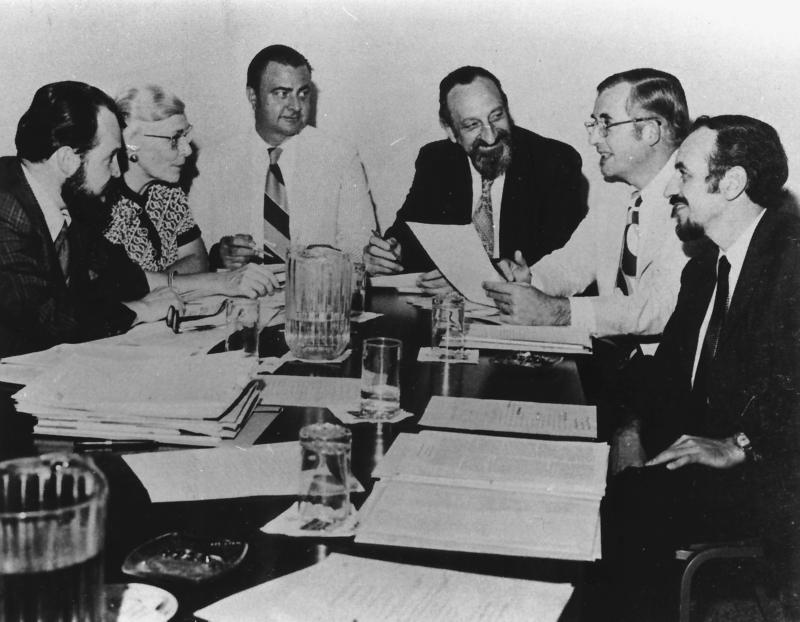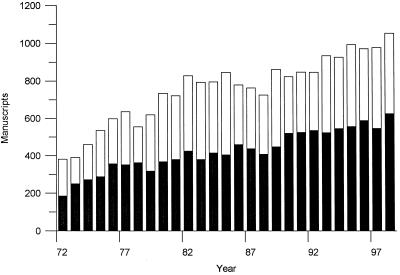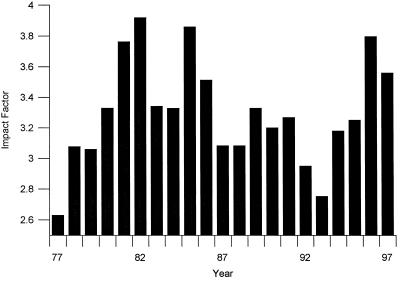The first issue of Antimicrobial Agents and Chemotherapy appeared in January 1972, but other publications concerned with antibiotics were involved in its gestation (3). From 1951 to 1962 a journal titled Antibiotics and Chemotherapy was issued monthly. In 1955 a second journal, known initially as Antibiotic Medicine and from 1956 as Antibiotic Medicine and Clinical Therapy, appeared, with a focus on clinical applications. It merged with Antibiotics and Chemotherapy in 1961, but the combined effort ceased publication in 1962.
Meanwhile, from 1953 through 1959 annual symposia about antibiotics were sponsored by the U.S. Department of Health, Education, and Welfare and the Food and Drug Administration, in collaboration with these monthly journals. The proceedings of each conference were recorded in an Antibiotics Annual. In 1960 a similar conference was sponsored by the Society for Industrial Microbiology, and its proceedings were published as the Antimicrobial Agents Annual 1960. In 1961 the American Society for Microbiology (ASM) organized the first Interscience Conference on Antimicrobial Agents and Chemotherapy (ICAAC). In accordance with the precedent set by previous conferences the proceedings were recorded in a book titled Antimicrobial Agents and Chemotherapy—1961 (AAC). These volumes continued annually as did a debate about whether a monthly journal would provide a better outlet for results. In favor of the book were convenience and tradition; against it were poor sales and the desire of investigators to reach a larger audience. Finally, in October 1970 the Editorial Board of AAC voted, after what was reported as “extensive discussion” to discontinue the annual volume and create a monthly journal, covering the same interdisciplinary subject area. It was further resolved that authors of papers presented at ICAAC be encouraged to submit their manuscripts for consideration to the new journal, or an existing ASM journal depending on the subject matter, and that existing sections about antimicrobial agents in Applied Microbiology, Infection and Immunity, the Journal of Bacteriology, and the Journal of Virology be discontinued and relevant papers be incorporated into the new journal (1).
The first volume of AAC the journal cost $10 annually to members of ASM and $40 to nonmembers and contained 184 articles. Three hundred eighty-two manuscripts had been submitted for consideration that year, so the acceptance rate was 48%, a good deal lower than the rate for AAC the book, where only 7 to 23% of manuscripts had been rejected or withdrawn (2).
Gladys L. Hobby (1910–1993) was the founding editor. She had been a researcher at the Columbia University College of Physicians and Surgeons from 1934 to 1944, a microbiologist at Pfizer, Inc., from 1944 to 1959, and chief of the Veterans’ Administration Special Research Laboratory, East Orange, N.J., from 1959 until her retirement in 1977. She had edited AAC the book from 1965 to 1970 and brought with her from its editorial board Walter Celmer, Joel Flaks, and Leon Schmidt and added Edward Hook as editors of the new journal (Fig. 1). Assisting these Editors were a board of 65 experts from the United States and abroad who were called on as reviewers.
FIG. 1.
Cover photo from ASM News, August 1971. From left to right are L. Leon Campbell (Chairman of the Publications Board), Gladys Hobby, Walter Celmer, Robert Day (Managing Editor of ASM Publications), Edward Hook, and Joel Flaks.
In its now 28 years of publication, AAC has had four editors in chief and 22 editors (Table 1). Leon Schmidt (1909–1989) succeeded Gladys Hobby in 1980. He directed the Christ Hospital Institute for Medical Research in Cincinnati, Ohio, from 1936 to 1968 and was Associate Director of the Southern Research Institute, Birmingham, Ala., from 1969 to 1976 and Professor of Pharmacology at the University of Alabama Medical Center. His special interests included chemotherapy of bacterial diseases, tuberculosis, and malaria and the pharmacology of antimicrobial agents. Dr. Schmidt set high standards, and his letters to authors were famously thorough. Even a favorable letter from him about a manuscript could be an unsettling experience. He felt particularly strongly that “generation” was undefinable as a term to describe classes of antimicrobial agents and banished it from the pages of AAC.
TABLE 1.
Editors of AAC
| Editor | Term |
|---|---|
| Gladys L. Hobby | 1972–1980a |
| Walter D. Celmer | 1972–1980 |
| Joel G. Flaks | 1972–1981 |
| Edward W. Hook | 1972–1981 |
| Leon H. Schmidt | 1972–1980, 1980–1985a |
| Herbert L. Enis | 1977–1987 |
| Robert L. Hamill | 1980–1985 |
| George A. Jacoby | 1980–1990, 1995–a |
| John A. Washington II | 1981–1991 |
| Robert C. Moellering, Jr. | 1983–1985, 1985–1995a |
| Peter G. Welling | 1984–1988 |
| Christine C. Sanders | 1984–1994 |
| Michael Barza | 1985–1995 |
| Jack W. Gwaltney, Jr. | 1985–1990 |
| Lawrence E. Bryan | 1987–1992 |
| George L. Drusano | 1989–1998 |
| Thomas D. Gootz | 1990–1995 |
| Frederick G. Hayden | 1990–1995 |
| Herbert A. Kirst | 1991–1996 |
| Barbara E. Murray | 1992– |
| Karen Bush | 1994– |
| Michael N. Dudley | 1995– |
| George M. Eliopoulos | 1995– |
| Spotswood L. Spruance | 1995– |
| Lowell S. Young | 1996– |
| William A. Craig | 1998– |
Editor in chief.
Robert Moellering, Jr., was editor in chief from 1985 to 1995. He trained in medicine and clinical infectious disease at Harvard Medical School and the Massachusetts General Hospital in Boston, Mass., and, as the Shields Warren-Mallinckrodt Professor of Medical Research at Harvard Medical School, he has headed departments of medicine at the New England Deaconess Hospital and subsequently the combined Beth Israel Deaconess Medical Center. Dr. Moellering brought broad clinical and laboratory experience with antibiotics to the post and was particularly responsible for developing minireviews and letters to the editor as regular features of the journal. Twenty-six minireviews were collected and published in a separate volume (4). The current editor in chief, like his predecessor, trained in medicine and infectious disease at Harvard Medical School and the Massachusetts General Hospital and now heads the infectious disease section at the Lahey Clinic in Burlington, Mass. He has a particular interest in β-lactamases and the genetic basis for bacterial resistance to antibiotics.
All the editors share the task of accepting or rejecting manuscripts. The number of active editors has grown from five to eight as the number of manuscripts submitted each year has increased and now exceeds 1,000 (Fig. 2). Initially, each editor covered an area such as susceptibility, mechanism of action, or pharmacology, but over the years some editors have been assigned particular antibiotic classes instead of subject areas. Authors are encouraged to recommend reviewers. Part of the editor’s job is to pick the most appropriate manuscript evaluators based on their expertise and also critical insight, familiarity with the journal, and speed of response. The Editorial Board has grown along with the publication and now includes 119 experts from 10 countries. Bernard Weisblum has the distinction of being the only representative of the 1972 editorial board still in service. The acceptance rate has varied somewhat from year to year, but between 1972 and 1998 it has averaged 56%.
FIG. 2.
Numbers of manuscripts received and accepted (filled portion) by AAC.
Over time the journal has become much more international. In 1972 77% of the published articles came from the United States. In 1975 the percentage was 70%, in 1980 and 1987 60%, by 1996 46%, and in 1998 44%, with investigators in Japan, France, the United Kingdom, Canada, Germany, Spain, Italy, The Netherlands, and Belgium, in decreasing order, publishing at least 10 articles. In 1972 21% of U.S. articles came from pharmaceutical companies and 8% came from government institutions, such as the National Institutes of Health or the Centers for Disease Control. In 1998 the share from industry had declined to 16%, with again 8% from government laboratories. Support for U.S. articles from predominantly academic sources (those from neither industry nor government) has also changed. In 1972 55% of the published articles acknowledged government (predominantly NIH) support and 25% acknowledged assistance from the pharmaceutical industry. In 1998 the number receiving government support had declined to 45% and the number acknowledging industry support had increased to 46%. Furthermore, since 1972, government support has shifted from articles concerned with antibacterial agents to those directed toward human immunodeficiency virus and other pathogens affecting individuals with AIDS. Whether changes in government support have influenced or followed the direction of research on antimicrobial agents would be an interesting topic for further research.
Subject categories have also changed over time (Table 2). The numbers of articles concerned with mechanisms of resistance, antiviral agents, and pharmacology have increased, while studies on susceptibility and experimental or clinical therapeutics have held steady, and the numbers of articles dealing with chemistry, mechanisms of action, and analytical procedures have declined. Minireviews began to appear in 1985 and have been one of the most popular features of the journal. Letters to the editor were added in 1986 and can contain new data as well as comments about published articles. In 1991 sections for antivirals and biological response modifiers were added. From the outset articles on cancer chemotherapy have been welcome but rarely submitted.
TABLE 2.
Distribution of articles published in AAC in selected years
| Sectiona | No. of manuscripts (% of total)
|
|||||
|---|---|---|---|---|---|---|
| 1972 | 1978 | 1982 | 1988 | 1992 | 1998 | |
| Chemistry | 20 (11) | 9 (2) | 7 (2) | 4 (1) | 6 (1) | 3 (0) |
| Mechanisms of action | 36 (20) | 54 (15) | 70 (16) | 53 (13) | 56 (10) | 46 (7) |
| Mechanisms of resistance | 16 (9) | 53 (15) | 45 (11) | 67 (17) | 77 (14) | 155 (25) |
| Susceptibility | 36 (20) | 105 (29) | 120 (28) | 97 (24) | 104 (23) | 122 (19) |
| Biologic response modifiers | 6 (1) | 17 (3) | ||||
| Analytical procedures | 22 (12) | 26 (7) | 26 (6) | 7 (2) | 0 (0) | 3 (0) |
| Antiviral agents | 9 (5) | 12 (3) | 7 (2) | 10 (2) | 63 (12) | 69 (11) |
| Experimental therapeutics | 20 (11) | 37 (10) | 37 (9) | 52 (13) | 64 (12) | 86 (14) |
| Clinical therapeutics | 12 (7) | 25 (7) | 37 (9) | 28 (7) | 25 (6) | 19 (3) |
| Pharmacology | 13 (7) | 41 (11) | 76 (18) | 75 (18) | 121 (17) | 100 (16) |
| Minireviews | 13 (3) | 13 (2) | 6 (1) | |||
| Total | 184 | 362 | 425 | 406 | 535 | 626 |
Section headings were introduced in 1975 and by 1982 had reached almost their current form. Minireviews were first published in 1985. Sections for antivirals and biological response modifiers were added in 1991. For years prior to 1991 the distribution of manuscripts has been calculated according to the present section headings.
In 1972 instructions to authors for AAC were far simpler than at present and occupied 1 rather than 18 pages. Then, the masthead of AAC stated that the journal was “devoted to the dissemination of knowledge relating to all aspects of antimicrobial agents and chemotherapy, including cancer chemotherapy” but no further attempt was made to differentiate the scope of the journal, and this omission contributed to competition between other journals and AAC for particular kinds of papers dealing with antibiotics. Editors of the Journal of Clinical Microbiology have fought to publish manuscripts describing susceptibility testing and levels of antimicrobial agents in blood, while AAC and Journal of Bacteriology (JB) editors have been rivals for articles on mechanisms of antibiotic action and mechanisms of resistance.
The apparently simple statement of scope in the current Instructions to Authors is the result of years of discussions at Publication Board meetings and testy letters between editors in chief. The conflict with the Journal of Clinical Microbiology was resolved in 1982 by assigning to it studies involving commercially available kits used in clinical laboratories “to measure the activities of established antimicrobial agents or their concentrations in body fluids,” quality control procedures for determining susceptibility to antimicrobial agents in clinical laboratories, and studies using antimicrobial or antiparasitic agents “as tools in the isolation, identification, or epidemiology of microorganisms associated with disease.” Manuscripts on all other aspects of antimicrobial, antiparasitic, or anticancer drugs, and specifically reports describing the development or modification of assay methods and validation of their sensitivity and specificity, were to remain the province of AAC.
The dispute with JB was more protracted. The areas of overlap between the two journals included resistance plasmids, antibiotic-resistant mutants, mechanisms of action, and, to a certain extent, bacteriocins. After discussions in 1975 guidelines were proposed whereby papers that concerned the antimicrobial agent itself or its mode of action were to be assigned to AAC while if the agent was used as a probe or tool to study basic cellular attributes it belonged to JB. In the 1980s the editors of AAC still felt that too many papers published in JB belonged in their journal and were particularly unhappy about the JB practice of sending manuscripts out for review and only when reviews returned deciding that the submission should be sent to AAC. A system eventually evolved in which the ASM Publications Office in Washington, D.C., screened JB submissions for manuscripts dealing with antibiotic resistance or mechanism of action, which were evaluated by the appropriate AAC editor, and, if he felt that the paper belonged in AAC, passed by the chairman of the Publications Board, who made the final assignment to one of the two journals. The editor in chief of JB was not happy with this arrangement, but it lasted for several years. In time AAC established its own reputation as a venue for basic studies of antimicrobial action and resistance, and the scope battle subsided.
One measure of a journal’s success is its impact factor, as calculated since 1977 by the Institute for Scientific Information in Philadelphia, Pa. AAC’s impact factor (the average number of times an AAC article has been cited in the medical literature in the 2 years preceding evaluation) has been 3.00 or above since 1978, except for brief dips in 1992 and 1993 (Fig. 3). There is no separate category for journals dealing with antibiotics or infectious diseases, but in 1997 AAC’s impact factor of 3.560 placed it 10th among microbiology journals and 16th among those concerned with pharmacology.
FIG. 3.
Impact factors for AAC.
The success of the journal can be attributed to the vision of its founders, who from the outset made its scope wide and its approach interdisciplinary. Manuscripts have been welcome from industry, government laboratories, hospitals, and academic centers and have been evaluated by editors and reviewers from the same broad range of backgrounds. As the prestige of publishing in AAC increased, the journal has become increasingly international. The tangible reward for serving the journal has been gastronomic: a breakfast at ICCAC for the editorial board and a dinner as well for the editors, but all involved have enjoyed polishing and prodding manuscripts into the best possible products for publication.
REFERENCES
- 1.Hobby G L. ASM to publish new journal. ASM News. 1971;37(3):1–2. [Google Scholar]
- 2.Hobby G L. Antimicrobial Agents and Chemotherapy, annual report. ASM News. 1971;37(3):31–32. [Google Scholar]
- 3.Hobby G L. Antimicrobial Agents and Chemotherapy. ASM News. 1974;40:327–329. [Google Scholar]
- 4.Moellering R C Jr, editor. Frontiers in antimicrobial chemotherapy. Washington, D.C: American Society for Microbiology; 1993. [Google Scholar]





